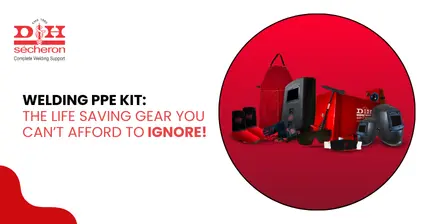Welding Rods: Different Types and Tips for Properly Storing and Handling
Choosing the right welding rods plays a crucial role in achieving strong and reliable welds. Welding rods, also known as welding electrodes, are an essential component of the welding process. They come in various types, each specifically designed for different welding applications and materials.
Here, we have listed the different types of welding rods that are available with valuable tips for properly storing and handling them.
Understanding Welding Rod Types
To handle and store the welding rods in the correct manner it’s important to understand their types since they are categorized based on their composition and intended use.
a) Mild Steel Rods (E6010, E6011, E6013): Ideal for welding mild steel and widely used in general fabrication, construction, and maintenance work.
b) Stainless Steel Rods (E308, E309, E316): Designed for welding stainless steel rod, they offer excellent corrosion resistance and are commonly used in food processing equipment, chemical plants, and architectural applications.
c) Aluminium Rods (ER4043, ER5356): Specifically formulated for welding aluminium and its alloys. They are commonly used in automotive, aerospace, and marine industries.
d) Cast Iron Rods (ENi-CI, ENiFe-CI): Suitable for welding cast iron components, such as engine blocks, pipes, and machinery parts.
e) Tungsten Electrodes (WT20, WC20): Used in Tungsten Inert Gas (TIG) welding for their high melting point and excellent electrical conductivity.
Tips and Tricks for Storing Welding Rods
Proper storage of welding rods is crucial to maintain their quality and performance. Here are some essential tips for storing your welding rods:
a) Keep them dry: Moisture in welding rods cause porosity and weak welds. Store rods in a dry location. Use airtight containers or rod ovens with low humidity levels.
b) Protect from extreme temperatures: Excessive heat or cold alters the chemical composition of welding rods. Store them in a temperature-controlled environment, away from direct sunlight, open flames, or freezing conditions.
c) Organize by type: Organize your welding rods by type and label them accordingly. This saves time and prevents the accidental use of the wrong rod.
d) Avoid contamination: Dirt, oil, and moisture can compromise weld quality. Handle welding rods with clean, dry gloves. Avoid touching the electrode portion with bare hands.
Handling Welding Rods with Care
a) Avoid dropping or mishandling rods: Welding rods are delicate and are easily damaged if dropped or mishandled. Ensure that the rod's coating doesn’t chip off due to impact when transporting or moving them.
b) Inspect for damage: Visually inspect welding rods for cracks, bent ends, or excessive rust. Discard damaged rods to prevent weld defects.
c) Use the right storage containers: Invest in quality rod storage containers that provide adequate protection against moisture, dust, and physical damage. Avoid using improvised containers that may fail to keep your rods safe.
At D&H Secheron, renowned welding electrodes manufacturers, we are committed to providing high-quality welding materials. Our range of welding rods are designed to meet the diverse needs of various industries. Visit our website to explore our product offerings and enhance your welding experience.
11 May 2025 | Welding
An In-Depth Exploration of Low-Alloy Steel: Your Comprehensive Guide
11 May 2025 | Welding
Nagpur - Bori - Tuljapur Road MSH-3 in Yavatmal District (Maharashtra)
11 May 2025 | Welding
Guidelines to Understand Gas Welding: Applications, Advantages & Disadvantages
11 May 2025 | Welding
3 Tips for Finding the Best Mild Steel Electrode for Your Application
11 May 2025 | Welding
How to Select the Right Welding Filler Wires for Stainless Steel Welding?
11 May 2025 | Welding
Building the Narendra Modi Stadium with Norma V and Autotherme-1 Electrodes
11 May 2025 | Welding
Low Alloy Steel Welding in a (PEB) Pre Engineered Building Structure
11 May 2025 | Welding
Tips for Flawless Welds with Stainless Steel Electrodes: Pros and Cons
11 May 2025 | Welding
Exploring Applications and Benefits of Stainless Steel Welding Electrodes
11 May 2025 | Welding
Welding Basics: Joining Metals with Heat and Pressure - A Beginners Guide
11 May 2025 | Welding
Distinguishing Low-Alloy Steel from High-Alloy Steel: Understanding the Variations
11 May 2025 | Welding
Hard Facing Wire - Understanding the Process and Achieving Optimal Result
11 May 2025 | Welding
Exploring the Advantages of Stainless Steel Electrodes in Welding Applications
11 May 2025 | Welding
Weathering Steel vs. Traditional Steel: A Comparative Analysis of Performance
11 May 2025 | Welding
Choosing the Right Welding Rod: Why 6013 Electrodes Might Be Your Ideal Option
11 May 2025 | Welding
Why 7018 Electrodes Are Preferred for High-Strength Welds in Pipeline Construction
11 May 2025 | Welding
Filler Wire vs. Stainless Steel Filler Wire: Understanding the Key Differences
11 May 2025 | Welding
Exploring the Impact of Filler Material on Welding Quality and Durability
11 May 2025 | Welding
Choosing the Right Cast Iron Electrode for Different Welding Projects
11 May 2025 | Welding
Top Advantages of Cast Iron Electrodes for Industrial Welding Applications
11 May 2025 | Welding
Key Benefits and Challenges of Using TIG Welding in Industrial Projects
11 May 2025 | Welding
5 Reasons Why 7018 Electrode is the Gold Standard for Welding Professionals
11 May 2025 | Welding
Top 5 Advantages of Flux Cored Arc Welding for Heavy-Duty Applications.png)
11 May 2025 | Welding
Lotherme-601: A Game-Changer for Restoring Shoulder Pins in Heavy Machinery
11 May 2025 | Welding
How D&H Sécheron Helped Repair a Rotary Kiln’s Cooler Section with LoTherme 352
11 May 2025 | Welding
Piston Repair for Mining Industry: Cost-Effective Solutions with LoTherme 468.webp)






.jpg)








































.jpg)
.jpg)

.jpg)

.jpg)





.jpg)
.jpg)
.jpg)



.webp)
.jpg)
.jpg)
.webp)
.jpg)






















.png)



.webp)

.webp)
.webp)



